King's Lynn
|
A relatively undiscovered historic port with loads to see and do |
|
An Introduction to King's Lynn
|
 King's Lynn
King's Lynn is often missed, as many pass by on the way to the North Norfolk Coast, Norwich or the Norfolk Broads. But to miss King's Lynn is a mistake. Originally known as Lin, a first settlement was established and in 1101, Bishop Herbert Losinga (the same Bishop that established Norwich Cathedral) founded St Margaret's Church and the town became known as Bishops Lin. Trade built up quickly around the waterways and a few years later a second settlement was established to the North. Lynn now consisted of 2 medieval settlements, each with its own church and marketplace. In 1537 King Henry VIII decided he would take control of the town from the Bishop of Norwich and it became known as King's Lynn and the town grew rich from trade within Britain and abroad. By the middle ages, the town ranked as the 3rd port of England and was considered as important as Liverpool. Although the town's importance declined from this heyday, King's Lynn today is a still an important regional centre for a largely sparsely populated part of England. |
Kings Lynn Guided Picture Tour
|
We start our tour of King's Lynn by entering the town through the grand South Gates and then parking the car in Boal Street car-park. The South Gates were built as part of the towns defences, which from the 13th century was a combination of sea and wall. This gatehouse was largely rebuilt during the 15th century and restored in the 1980's. Boal street car-park is situated near one of the main quays and is an immediate reminder of the maritime past that is very much in evidence today. |
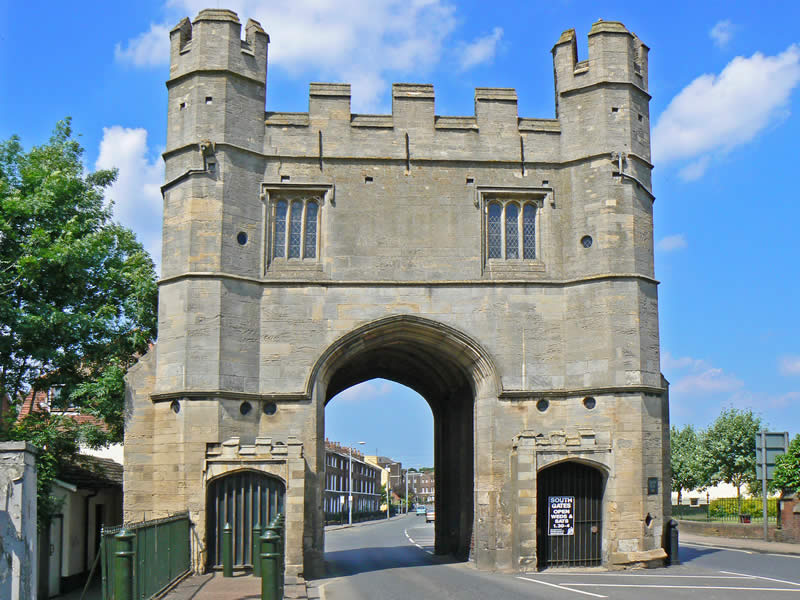
South Gate, the entry to Kings Lynn |
After parking the car, we cross Millfleet and walk along South Quay. Fishing has always been a strong part of Lynn's history. Queen Elizabeth I granted Lynn fishermen the right to " free and uninterrupted use of the Fisher Fleet for ever and ever"!! Lynn's whaling ships would sail to Greenland every March and return back here in July with their catch. On their return this quay would be full of excitement; today it is a peaceful place to sit and watch the odd boat float by from wharfs converted into a bars and restaurants. |
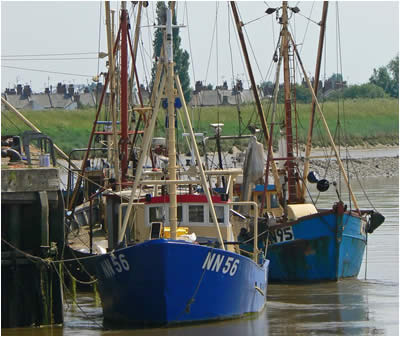
Fishing Boats near Boal Quay |
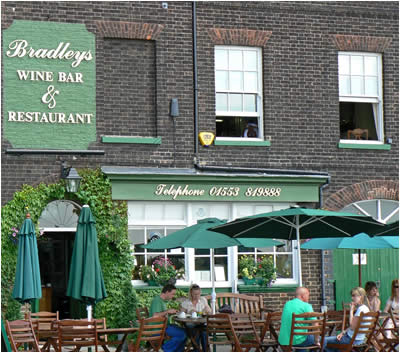
A Wine Bar and Restaurant on South Quay |
Continuing our walk along the quay's, we come to Purfleet Quay. In medieval times, this was a navigable waterway, taking boats into the heart of the town; it also marked the boundary between the two medieval settlements forming Lynn. Today it is nothing more than a peaceful inlet. |
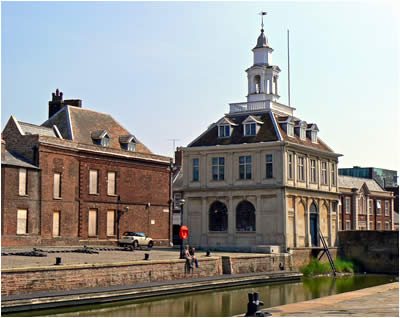
Purfleet Quay Today |
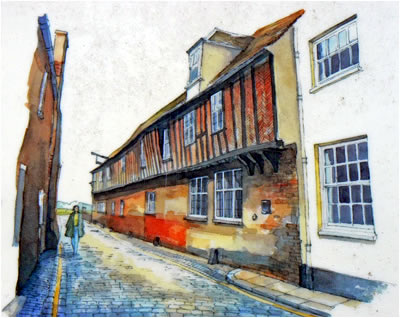
Medieval Lin, depicted on a local sign |
Sitting on Purfleet Quay is the Custom House. This magnificent building was constructed in 1684 and initially used as a merchants exchange. From 1718 right up to 1989, the building was used by Customs and Excise, hence the name. It has now been refurbished and houses interesting displays and the tourist information centre. |
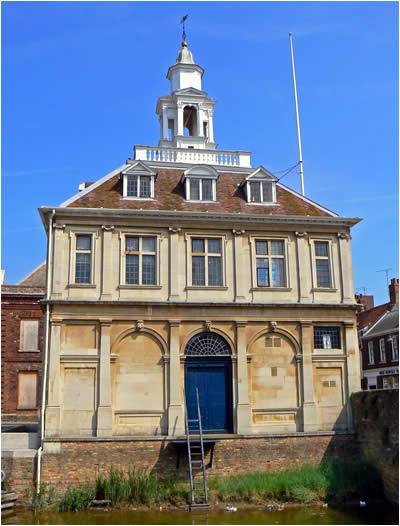
Custom House |
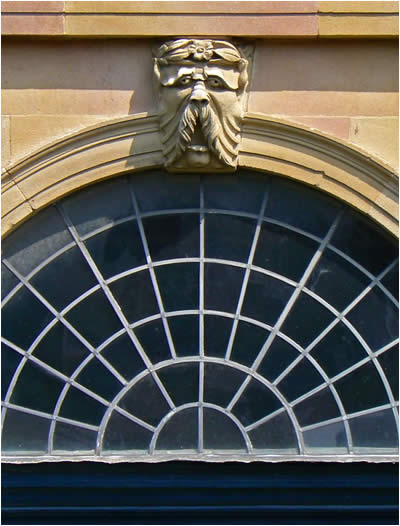
Stone Figure |
One name linked with King's Lynn is George Vancouver, you will see his name all around the town and a display in the Custom House explains his story. In 1792 George Vancouver was a captain in the British Royal Navy and sent to survey the North American coast from San Francisco right up to Alaska. Vancouver was the first European to enter the main harbour area of the present day City of Vancouver. The map drawn by Vancouver was so accurate that it was still used for navigation into the 20th century. |
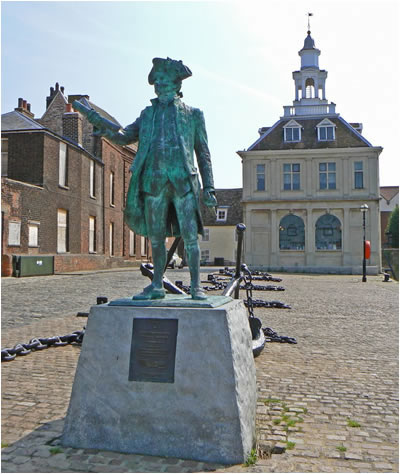
George Vancouver Statue |
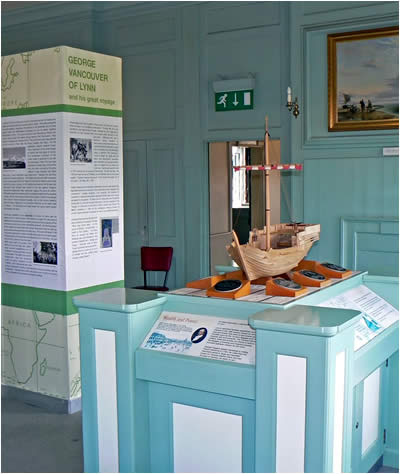
Vancouver Gallery in the Custom House |
George named many of the places he discovered after his friends, but he chose to name the inner harbour area Vancouver in 1792. This Canadian city is now home to over 2 million people and the largest city in Western Canada. It has been ranked as one of the most desirable places to live and also one of the cleanest city's in the world. |
We continue our tour along King Street, which contains many historic buildings that are based on original medieval structures. These buildings formed part of Lynn's second medieval settlement. |
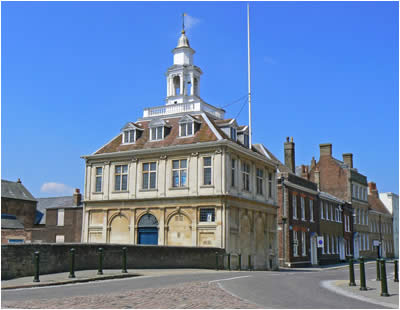
Looking along King Street |
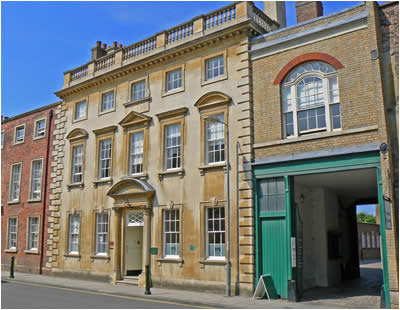
27 King Street |
Mid-way along King Street you will find Ferry Lane, leading to a ferry service to West Lynn. A ferry has been operating here for over 700 years and is still used today by commuters and shoppers to get to and from West Lynn. Little has changed with this service over the 700 years, with the exception of safety; in 1796 for example, 22 of the 30 passengers drowned when the ferry hit a barge. |
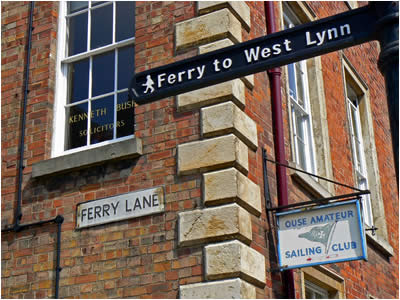
Ferry Lane |
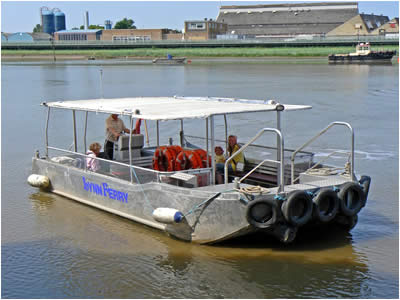
King's Lynn Ferry |
At the end of King Street we come to the Tuesday Market Place, dominated by the Corn Exchange and the Dukes Head Hotel. This is one of the largest medieval market places in England and would have originally opened directly onto the river. The Corn Exchange was built in 1854 with a Baroque facade featuring Ceres, the goddess of Corn! Originally built for local farmers to sell their corn, it is now used as a multi-function venue for concerts and community use. The Dukes Head Hotel was constructed in 1684 and was used by wealthy merchants to do business in the town. |
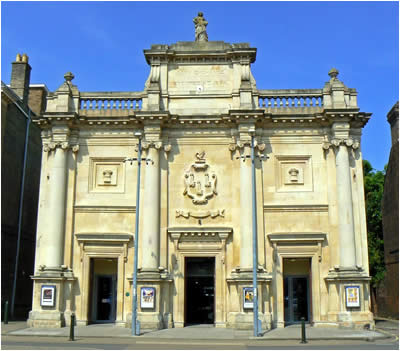
The Corn Exchange |
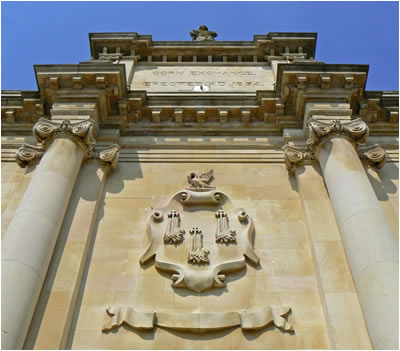
Looking up! |
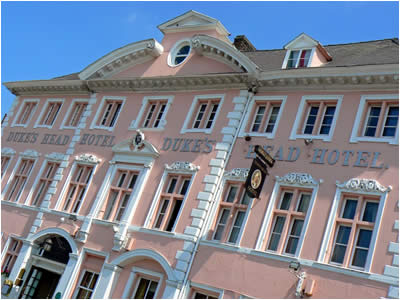
The Dukes Head Hotel |
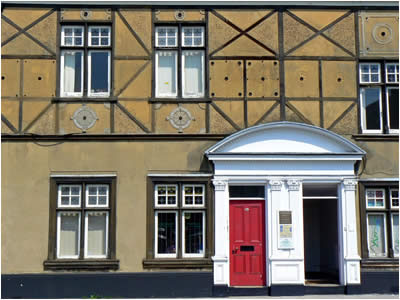
Houses around the market place |
The Tuesday Market Place was used for local punishment, with stocks, whipping post and gallows all situated here. One gruesome case was that of a young maidservant, who was boiled to death in 1531 for murder. |
To the north-east of the market place is St Nicholas Chapel, which was founded in 1145, but the building you see today was not completed until 1420. The chapel was the place of worship for the 2nd of Lynn's medieval settlements. Nearby is True's Yard Fishing Heritage Museum, where you can explore Lynn's maritime past in a building that was once 2 fishermen's cottages. |
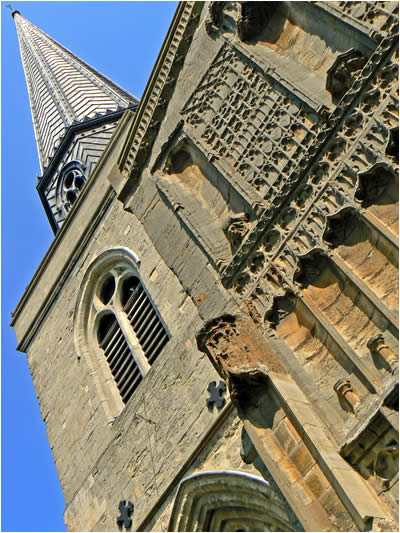
St Nicholas Chapel |
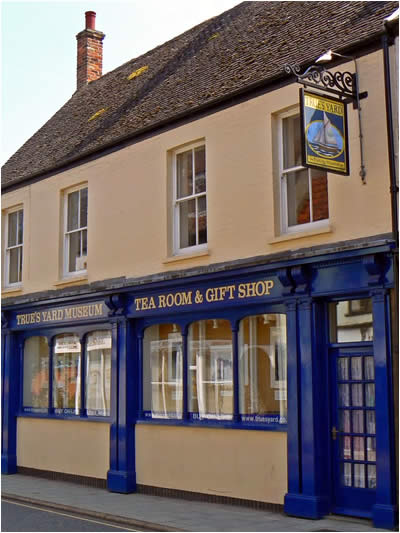
True's Yard Museum |
Off one side of the market place is the High Street, the main shopping street in King's Lynn. The street contains a mix of the usual High Street names and small local traders. Major brands include BHS, JD Sports, Game, HMV, Laura Ashley, Next, River Island, Waterstones. The Vancouver Quarter shopping centre contains stores such as TK Maxx, Millets, New Look and Argos. |
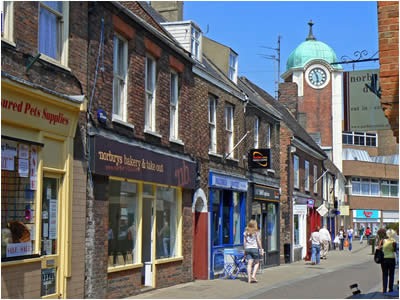
Shopping in King's Lynn |
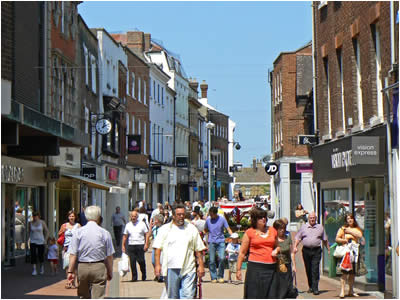
King's Lynn High Street |
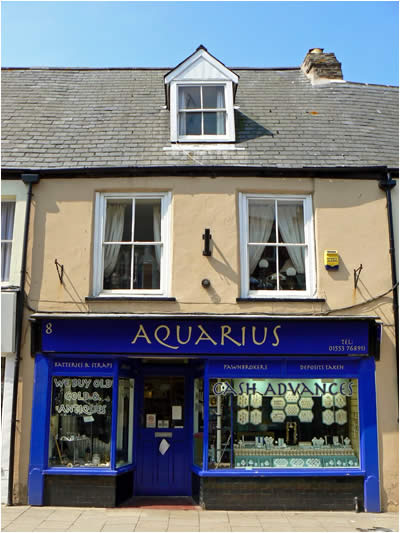
Local Shops |
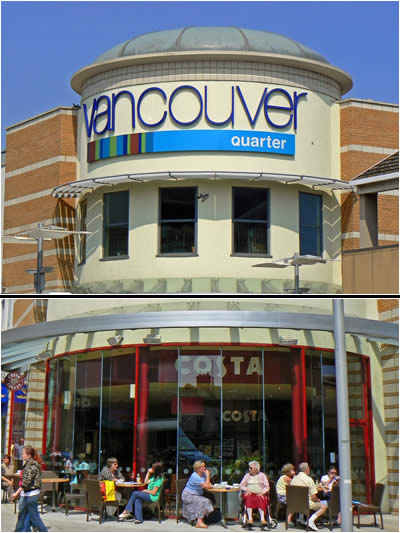
The Vancouver Shopping Centre |
At the end of the High Street, we come to a green open space containing 2 magnificent structures - Greyfriars tower and the town Library. Greyfriars came to King's Lynn in the 1230's and wasted no time in building a friary and during the early 1300's they even added running water! The friary was closed in 1538 by King Henry VIII but the tower was left intact as it contained a lantern and was a valuable beacon to shipping. Also on the site is King's Lynn library, built by the philanthropist Andrew Carnegie during the early 20th century. It is still the town's main library and staff say the basement is haunted by the ghost of a monk that still lives here! |
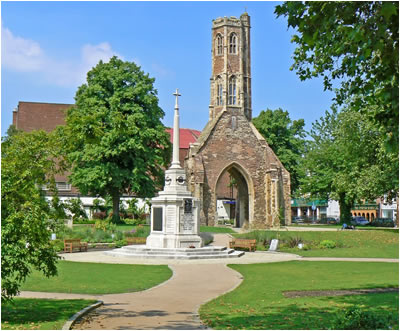
Greyfriars Tower |
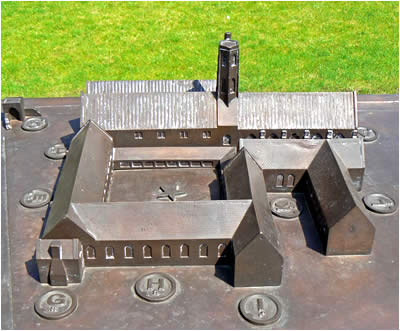
Model showing how the friary would have looked |
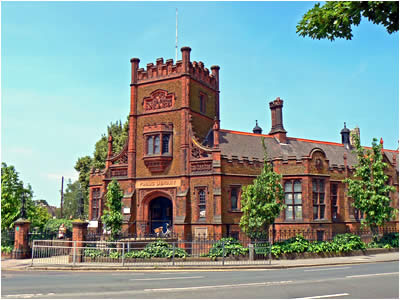
King's Lynn Library |

The Public Library, haunted by the ghost of a monk! |
Over the road is a park called the Walks. The park was established during the 18th century as an open space to relax and go for a stroll. It still serves this function today and is a lovely green space, with pond, streams and various structures. Its a great place for a picnic or a game of cricket in summer! |
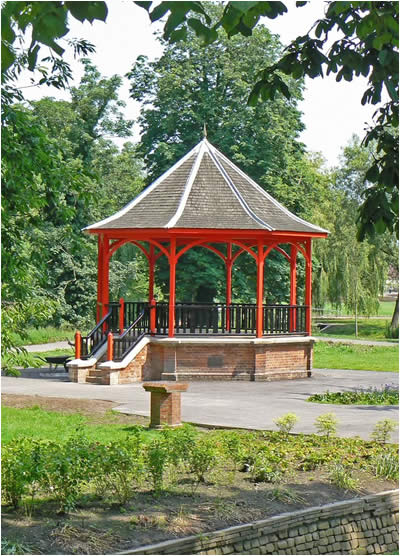
Park Bandstand |
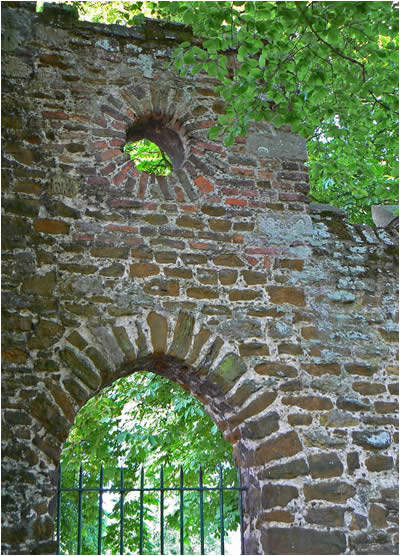
Park Old Walls |
Returning to the centre of town, we come to the historic quarter, containing many historic streets and buildings which formed the main part of the original Lynn settlement. Nelson Street marks the line of the old riverbank before it silted up, with buildings dating from the 18th century. The Valiant Sailor is a former Tudor Inn named after Jack Crawford, a sailor, who during the Battle of Camperdown in 1797 climbed a broken mast and nailed a flag to it. Hampton Court dates back to the 14th century and was used by merchants. John Hampton, a baker, added a complete new wing during the 17th century. |
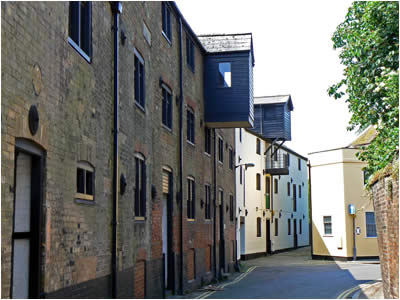
Nelson Street |
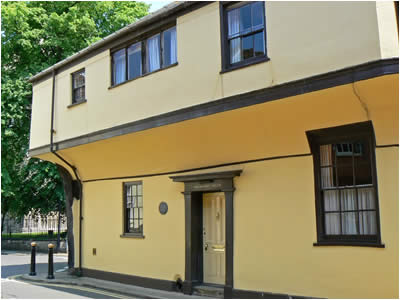
Valiant Sailor |
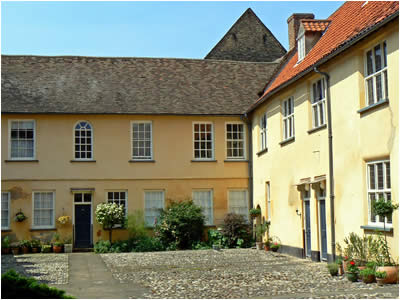
Hampton Court |
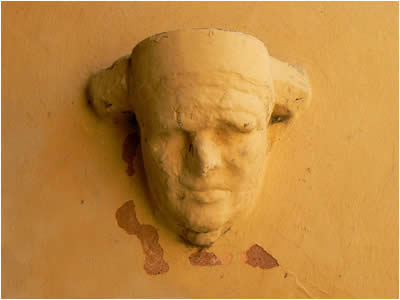
Face in Hampton Court! |
In the archway leading to Hampton Court, you will see a cannon ball which was supposedly fired across the river by the Earl of Manchester's army during the civil war in 1643. The cannon ball hit the church of St Margaret's, crashing through the west window! |
The highlight of the heritage quarter is the magnificent Town Hall, dating back to the 15th century. The building has a distinctive chequered flint front, impressive windows and the arms of both Queen Elizabeth I and King Charles II. The centerpiece of the complex is the Trinity Guildhall, located behind the main window. The town hall was expanded over the years, with the Gaol House added in 1784, which remained in police use until 1955. The gaol house is now a museum where you can hear the stories of local highwaymen, smugglers, robbers and the punishments that were given to them. The museum also contains the Regalia room, containing fine civic treasures such as the King John Cup. |
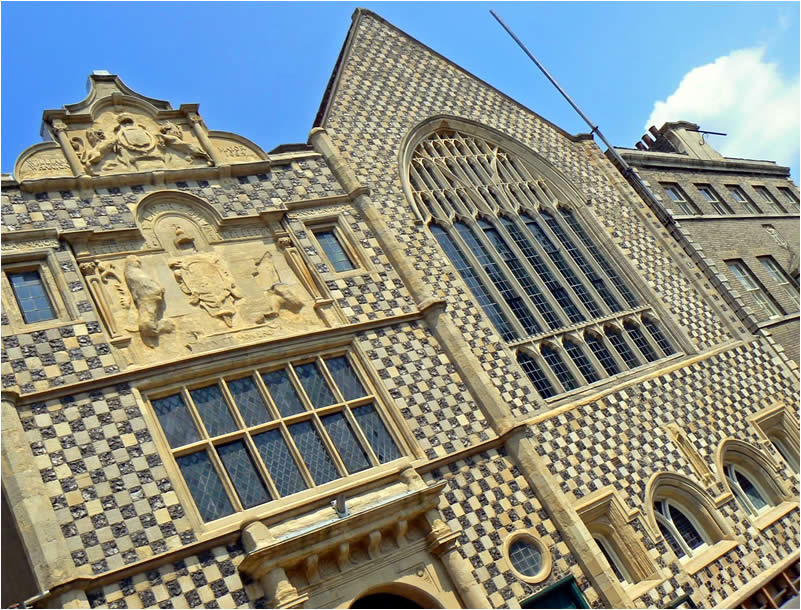
Flint Chequered Patterns on the Town Hall |
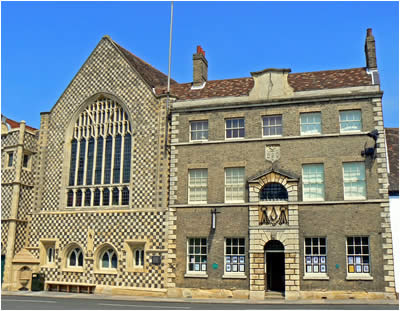
Town Hall |
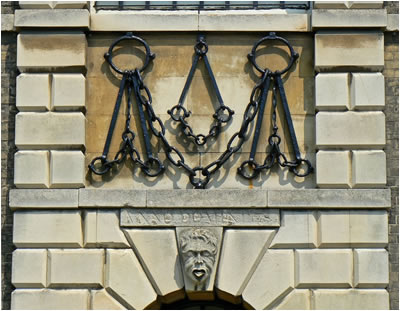
Gaol House |
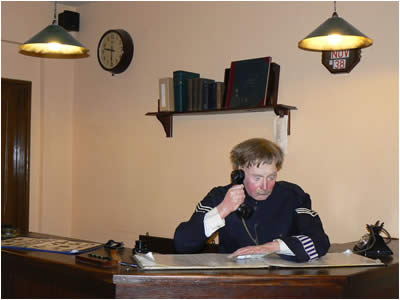
Gaol House Police Reception |
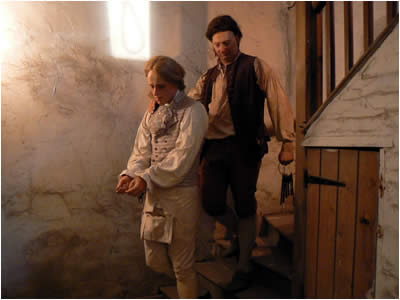
Gaol House Prisoner |
Adjacent to the Town Hall is a converted town house containing the Museum of Lynn Life. This museum allows you to explore everyday life in King's Lynn through the ages. There are recreated rooms, costumes, toys and a delightful garden. |
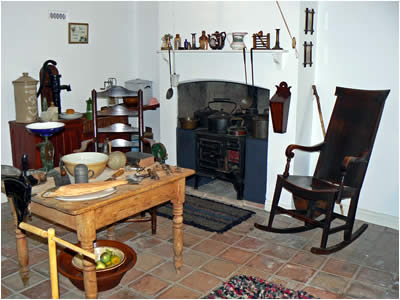
Victorian King's Lynn Life |
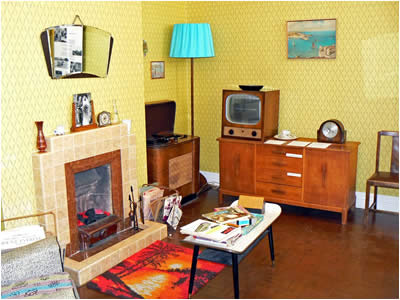
1950's King's Lynn Life |
Opposite the town hall is the Saturday Market and the magnificent church of St Margaret's, forming the centre of the first medieval town. Work started on the church of St Margaret's in 1101, however little remains of this church and the building we see today dates from the 13th century. The church has many interesting features including flood markers outside the main door - showing how vulnerable to flooding this area is. Inside, you will find 2 of the largest brasses in England, dating from the 14 century, with one depicting a beloved dog. |
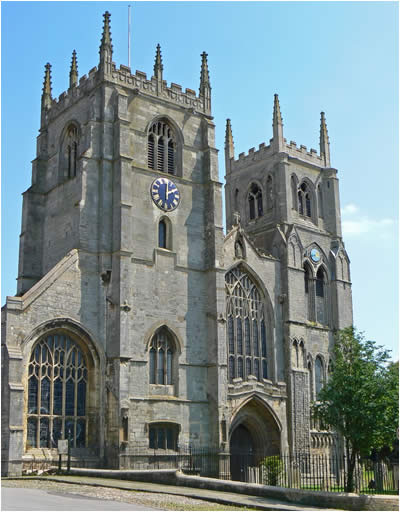
St Margaret Church |
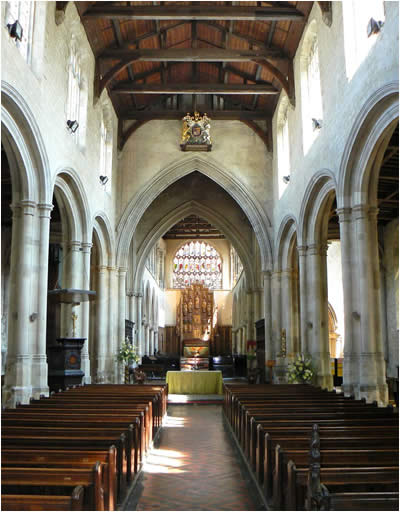
Inside St Margaret's |
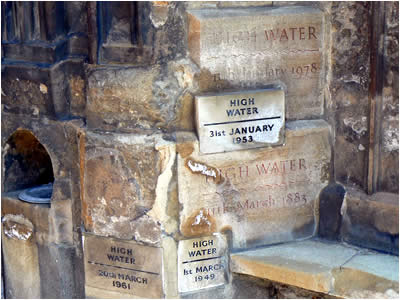
Flood Level Indicators |
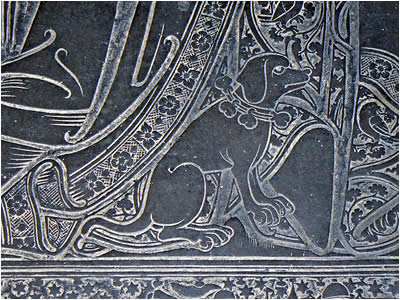
Brass Rubbings featuring a dog! |
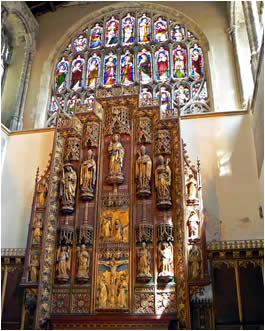 Altar and East Window
Altar and East Window |
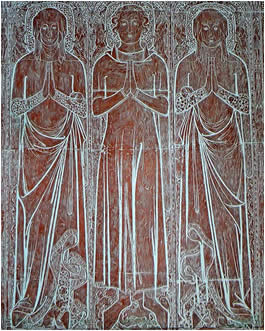
Brass Rubbing Figures |
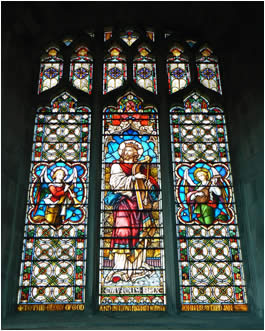
Stained Glass Window |
King's Lynn Summary of What to SEE and DO
|
 Enjoy the views of the Great Ouse |
 Learn about the Wash at Green Quay |
 Stroll along South Quay and Purfleet Quay |
 Discover the Custom House |
 Enjoy a show at the Corn Exchange |
 Explore the shops of the High Street |
 Enjoy a walk or picnic in the park |
 Learn about the Greyfriars and their monastery |
 Wander the streets of the Historic Quarter |
 Visit the Gaol House and its 200 year old cells |
 Explore everyday Lynn Life through the ages |
 Discover St Margarets church and its secrets |
|
 Take the ferry to West Lynn |
|
|
Our Verdict
|
King's Lynn competes with any town in England for history. It is relatively undiscovered containing a wealth of historic buildings and tales to go with them. Do not be put off by its industrial outskirts and make time to visit the town centre - you will not be disappointed. |
|
|
TOUR INDEX |
|
|
|
|
|
|
|
|
|
|
|
|
|
|
|
|
NEARBY PICTURE TOURS |
|
|
|
|
|
|
|
|
TOURIST ATTRACTIONS |
 |
|
|
OTHER PICTURES |
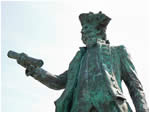
George Vancouver |
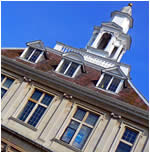
The Custom House |
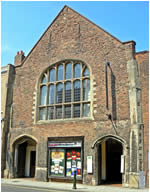
St George's Guildhall in King Street. The largest 15th century guildhall remaining in Britain. |
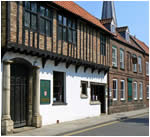
Tudor Rose Hotel |
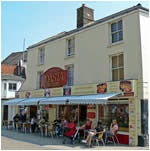
Roasta Food Court in the High Street |
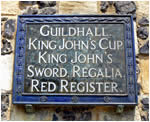
Sign on the Town Hall |
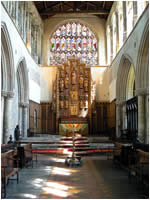
Inside St Margaret's |
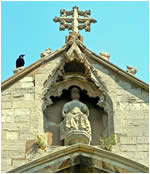
Cross and figure above the door of St Margaret's |
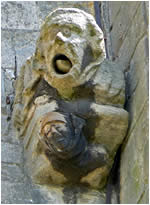
Gargoyle on St Margaret's |
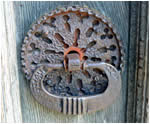
A Legend says that any wrongdoer touching the handle of St Margaret's church will gain temporary sanctuary! |
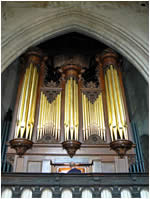
St Margaret's Organ |
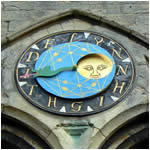
Tide clock on the front of St Margaret's |
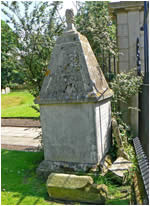
John Sparks Memorial |
MORE OF OUR WEBSITES |
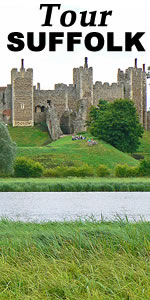 |
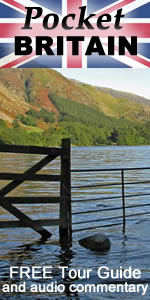 |
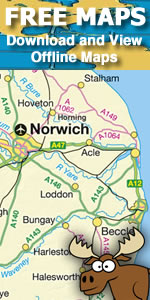 |
| |
|

